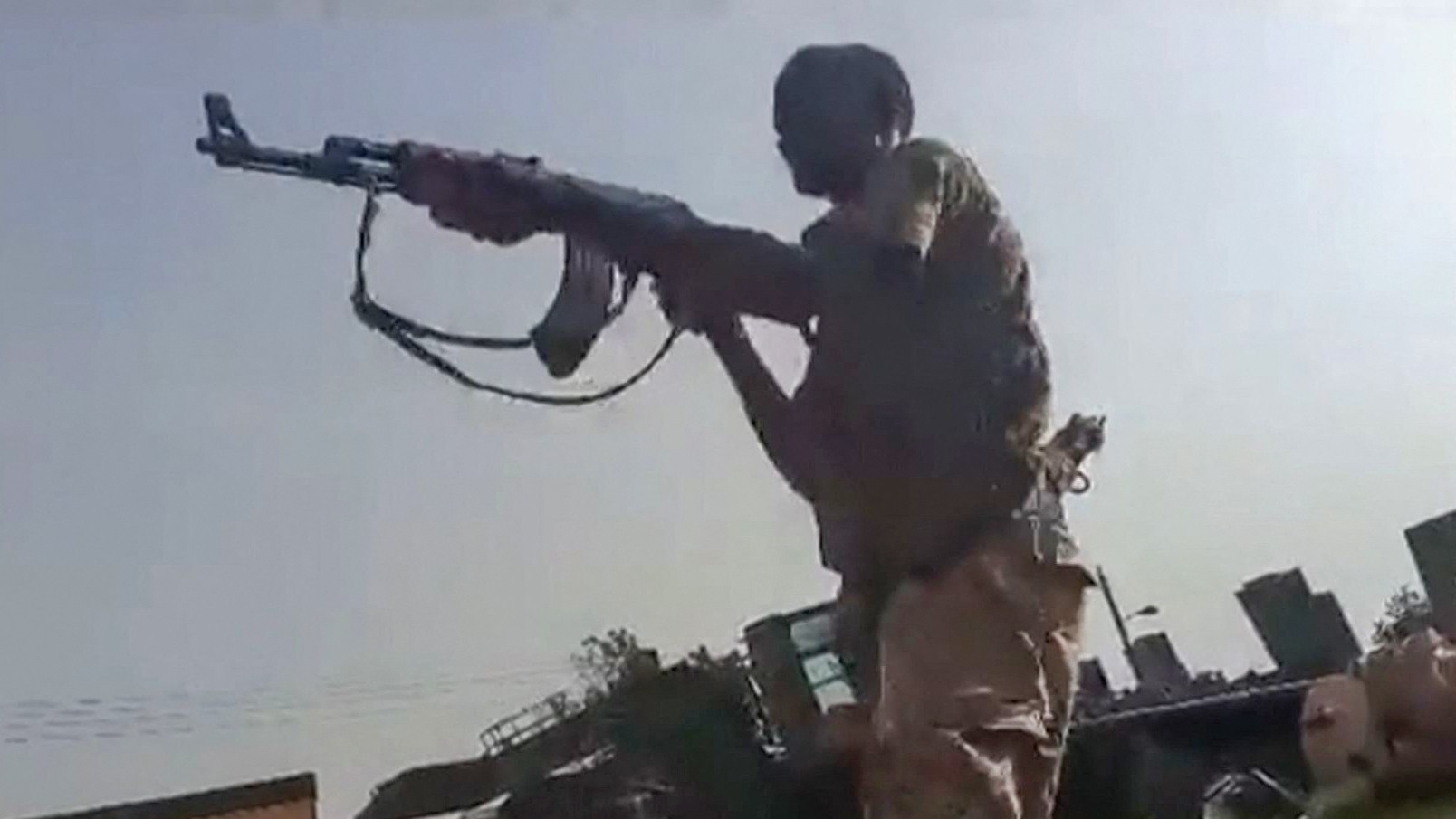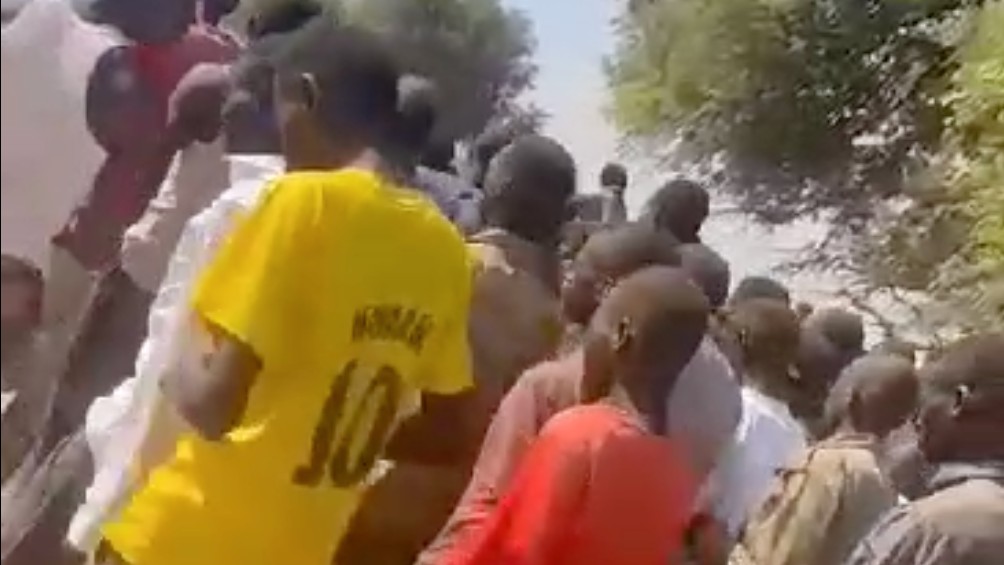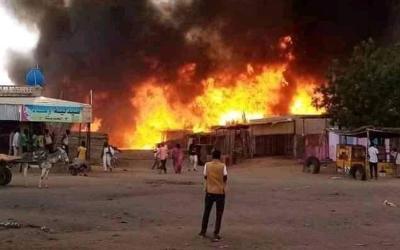Sudanese soldiers who fled Ardamata say army leadership abandoned them

Sudanese soldiers who fled a Rapid Support Forces (RSF) assault on Ardamata in West Darfur have told Middle East Eye they were abandoned by the military leadership, who left them without supplies and support.
Their withdrawal from an army base in the el-Geneina suburb on 4 November preceded a frenzy of killing, with witnesses and activists previously telling MEE that at least 1,300 people were massacred by the RSF paramilitary force and its allied Arab militias.
Four soldiers belonging to the Sudanese Armed Forces (SAF) said they were overwhelmed by a better-equipped RSF and forced to flee the 15th Infantry Division garrison in Ardamata for Chad.
They said their base was attacked with artillery and drone strikes.
“There was no equivalence between the capacities of our division and the attackers, which continued striking us with drones,” Salah Mohamed Abdul Rahman, a soldier who fled the garrison, told MEE from Chad.
New MEE newsletter: Jerusalem Dispatch
Sign up to get the latest insights and analysis on Israel-Palestine, alongside Turkey Unpacked and other MEE newsletters
“We ran out of weapons, munitions and even supplies. It is regrettable for me to say that the army leadership left us without supplies or munitions for a long time.”
The attack on Ardamata, which was being defended by soldiers in the garrison alongside members of the Masalit tribe who had taken up arms to protect their neighbourhoods, began on 2 November.
Over recent weeks, the RSF had successfully defeated SAF troops in Nyala and Zalingei, the state capitals of South Darfur and Central Darfur respectively, effectively leaving the majority of Darfur in the paramilitaries’ hands.
'The militias gathered groups of Colombians and opened fire on them randomly in Ardamata… it’s one of the last things I saw while I was running away'
– Abakar Ahmed
Darfur, Sudan’s sprawling western region, has been a key battleground since the war between the RSF and SAF broke out on 15 April.
“It was clear that our division was in need of reinforcements after the divisions in Zalingei and Nyala fell into the hands of the RSF,” Abdul Rahman said.
Another soldier, who wished to remain anonymous, said: “It’s no big secret that the divisions in Darfur were fighting without help from the central leadership.
“We withdrew to Chad, surrendered and handed over our weapons to the Chadian army on the border. It was very bitter, feeling that we didn’t have the chance to fight and protect our people,” he added.
A history of killings
Ardamata was the last place in West Darfur to remain in SAF control after June, when the RSF and its allies seized the state capital, el-Geneina.
The fall of el-Geneina was followed by days of mass killings, when hundreds of people belonging to the Masalit, a Black African tribe, were massacred by RSF fighters and Arab militiamen.
Those killings, described by human rights organisations as ethnic cleansing, are being investigated by the International Criminal Court.
Darfur was the scene of an ethnic-based conflict between 2003-2005, when the government of then president Omar al-Bashir used a force known as the Janjaweed to fight a rebellion by Black tribal fighters who revolted against longstanding marginalisation and discrimination.
The Janjaweed, a collection of Arab fighters who today form the backbone of the RSF, targeted Black African civilians in a conflict that killed around 300,000 people and displaced millions more.
After the June massacres, Masalit civilians sought protection from the Sudanese soldiers in the Ardamata garrison, and former rebels from the community took up arms to guard civilian neighbourhoods in the area and fight alongside the SAF troops.
A third soldier told MEE that he bitterly regretted being unable to protect the civilians of Ardamata, including the hundreds who sought protection from the garrison.
Middle East Eye asked the Sudanese Armed Forces for comment, without response.
However, SAF spokesperson Brigadier Nabil Abuaalh made a statement following the loss of Ardamata, saying the military would never abandon the region and accusing the RSF of committing widespread abuses.
“What happened in Darfur is a temporary situation and the SAF has its plan and resolve to liberate all the country from the RSF rebels,” he said.
The RSF has not responded to requests for comment on the allegations its forces and allies were responsible for abuses in Ardamata, including mass killings, sexual assault and the looting and destruction of civilian property.
Ardamata residents who escaped to Chad previously told MEE that Arab militias were combing through groups of people fleeing for the border, searching for soldiers and Masalit fighters, who they would then kill.
MEE has reviewed video footage purportedly showing scores of soldiers and Masalit fighters held by the RSF in an open area on Ardamata’s outskirts.
Ethnic violence
Witnesses and activists told MEE that the conflict between the RSF and SAF, which broke out over plans to fold the paramilitary force into the regular military, has clearly taken on an ethnic dimension in Ardamata.
Arab militiamen have backed the RSF and were responsible for many of the worst abuses, according to witnesses.
Meanwhile, Masalit armed groups fought on the other side, including fighters from the Sudanese Alliance, a rebel group previously headed by Khamis Abakar, the West Darfur governor reportedly killed while in Rapid Support Forces' custody.
Issa Omer, an SAF soldier now in Chad, told MEE that the Sudanese Alliance fighters mobilised to support the military after the el-Geneina massacres in June and Abakar’s killing.
“We were fighting together and the Sudanese Alliance was deployed around the army garrison, putting up checkpoints to defend the people of Ardamata, who are mainly Masalit,” he said.
The RSF has accused the Sudanese military of inflaming tensions in West Darfur by arming members of the Masalit community.
However, an SAF source said it was legitimate for the men to be provided with weapons, as the Sudanese Alliance was one of the rebel groups that formed a government-approved security force following the 2020 Juba Peace Agreement, which sought to bring fighting in Darfur to a close.
The Colombians
Former Sudanese Alliance rebels were not the only Masalit to take up arms.
Also fighting alongside the soldiers were “Colombians” - a term for hundreds of youth from Black African tribes in West Darfur, like the Masalit, who were displaced by previous fighting in the region. Around 2.5 million people displaced by the 2003-2005 conflict are living in camps across Darfur.
“Colombians” is a slang word for youth who have no families and have endured hardship, but nonetheless display an unusual strength.
According to human rights activists, Colombian fighters were killed in large numbers after the garrison’s defences collapsed.
Chad Ahmed Hajar, a lawyer and human rights activist in the Adre refugee camp in Chad, where thousands of Darfuris have fled, told MEE the Colombians were poor youth who armed themselves when people raided weapons stores in el-Geneina in June.
“The Colombians is a very special case in West Darfur and they were formed in response to continuous violence against civilians. They are made up of the homeless, orphans and victims of the war in Darfur,” Hajar said.
Before the latest conflict broke out, Hajar and his colleagues were working with these same youths to provide them with social, psychological and healthcare services.
“The Colombians have been subjected to repeated cycles of violence over the past decade,” he said. "As weapons are now in the hands of everyone in West Darfur, they carried weapons to defend themselves while the entire region is subjected to huge chaos.
“However, they have been subjected to extreme violence by the Arab militias after the army division in Ardamata fell.”
Sources showed MEE video footage showing dozens of men in captivity being lashed with a whip. According to the sources, the captives are Colombians.
Abakar Ahmed, an Ardamata resident who witnessed the killings and has fled to Chad, said the Arab militias specifically targeted the Colombians in the area, subjecting them to mass killings.
“The militias gathered groups of Colombians and opened fire on them randomly in Ardamata,” he recalled.
“This was very brutal and it’s one of the last things I saw while I was running away from Ardamata.”
Middle East Eye delivers independent and unrivalled coverage and analysis of the Middle East, North Africa and beyond. To learn more about republishing this content and the associated fees, please fill out this form. More about MEE can be found here.







